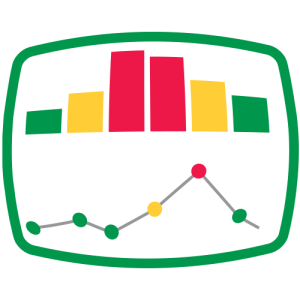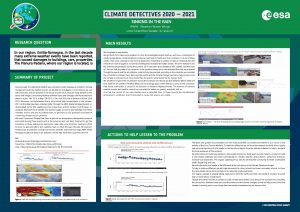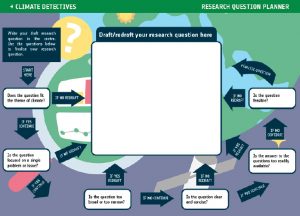
About Climate Detectives

Climate Detectives is a school project for students between the ages of 8 and 15 run by the European Space Agency (ESA) in collaboration with the national European Space Education Resource Offices (ESEROs) throughout Europe. Starting in 2022-2023, Climate Detectives is also open for school students up to 19 years old.
In this project students will embrace the role of Climate Detectives while learning about Earth’s environment. For that they will identify a local climate problem (Phase 1), investigate it by using real satellite images or their own ground measurements (Phase 2), and finally propose actions to help reduce or monitor the problem. At the end students will share their results with the ESA Climate Detectives community on the project platform (Phase 3). This way everyone can learn from their work and students can also raise awareness of the problem they have investigated.
Why participate?
By participating in the Climate Detectives project, students will understand Earth’s climate as a complex and changing system as well as learn the importance of respecting our environment. Students will have the opportunity to engage with scientists and climate experts through organised webinars as well as initiating and organising these opportunities themselves with local colleges, universities and other organisations.
The project objectives are:
• To promote the teaching and learning of STEM competences and skills, including scientific methodology, data collection, visualisation and analysis;
• To improve the younger generation’s awareness and knowledge of Earth’s climate, both as a global issue and in local environments, and prepare them for the climate challenges of this century.
Timeline
The project features three phases and takes place every school year, from the middle of September to the end of May. Teams have to register and submit an investigation plan in phase 1 in order to join the project. See the full timeline here.
Introduction to the different phases
Phase 1 – Identify a climate problem
In this phase, students will be asked to identify a climate problem that they would like to investigate as ‘Climate Detectives’. Students should define the problem based on questions that arise from their school studies and from observations in their local environment. Students will have to plan their investigation of the problem, including their research question and what Earth observation data they need to collect and what field/laboratory studies they require to answer the question. Planning is an important step in any investigation!
Scientists in the field of Earth observation and climate will then review the investigation plans and give their written feedback to all teams participating in the project.
The steps involved in phase 1:
Identify the research question
A research question is one of the most important components of any investigation. To identify a research question, students can:
Have a look to previous Climate Detectives entries in the project gallery and some of the feature projects;
Research local media and search for articles exposing local climate problems in your community;
Check for any reports on recent climate events that could help identify suitable questions;
Contact local environmental authorities to ask if they have concerns about local climate issues including flooding, storms or changes in biodiversity;
Identify geographical features and habitats suitable for investigation in your area e.g., school grounds, parks, woodland, rivers, mountain ranges, sandy beaches, etc.
Students can be guided to formulate a good research question using the following criteria or the research question planner:
Does the question fit the theme of climate?
Is the question focused on a single problem or issue?
Is the question too broad or too narrow?
Is the question clear and concise?
Is the answer to the question too readily available?
Is the question feasible (consider timeframe, access to resources, student capability)?
You can find the research question planner and more information about how to plan the investigation at the teacher guide.
Identify the data to be investigated
Once the research question is decided, teams must plan what Earth observation data they need to collect.
The data to be collected for the investigation can be either satellite or ground-based data retrieved from professional sources, or data obtained from measurements by students, or a combination of both. For example, teams can make weather observations and compare them with historical climate data.
How might local ground data be collected?
Observations
Measurements
Counting
Surveys
Laboratory experiments
Field experiments
How might satellite data be accessed?
Using satellite data, you can monitor changes happening to our planet, mapping deforestation, quantifying the amount of ice melting off glaciers or taking Earth’s temperature. Climate from Space and EO Browser are two online tools that give easy and free access to satellite data from different EO ESA missions. Visit the satellite data section for more information about these tools.
Submit the investigation plan
The final step in phase 1 is the submission of the investigation plan. The key items of information required are:
Project title
What is your research question?
Describe the local climate problem/issue you want to investigate.
What kind of Earth observation data will you use?
Describe how you plan to investigate the climate problem and which data you plan to analyse. Also, describe how you plan to access/collect the data.
Scientists in the field of Earth observation and climate will give feedback and recommendations about the investigation plan submitted.
You can find more information about phase 1 and the different steps in the teacher guide
Phase 2 – Investigate the climate problem
In this phase, students investigate the climate problem they identified in Phase 1. For that students will collect suitable data, compile this data, analyse their findings and draw conclusions.
During Phase 2, ESA or, where applicable, the National Coordinator will organize online events in which teams can “Ask a Scientist” and receive background information and tips.
The steps involved in phase 2:
Collect Data
Phase 2 is the time to begin gathering the data to answer the research question which was identified in Phase 1. The Earth observation data used by students for the Climate Detectives project may be ground measurements OR satellite data. Students may also use both types of data in their investigations.
It is important that any data collected is recorded and, to this end, students could have a logbook or recording sheets where relevant information is written down.
Evidence of students at work may also be documented by means of:
Photographs of location where data is being collected
Videos
Photographs of team members at work (make sure to follow GDPR rules for your school)
Screenshots of the data being collected
Labelled sketches of experiments in the field or in the laboratory
This may be useful in communicating the work done by the students during Phase 3 of the project.
 If students are using satellite data and images to research their climate problem, they should keep detailed notes including:
If students are using satellite data and images to research their climate problem, they should keep detailed notes including:
Cite the link to the applications being used
Date on which they searched for the data
Area searched
Record if it is current data or historic data
Retrieve and save the data
Download and save satellite images they want to use
To have more information about how to access EO data have a look to the satellite data section.
Organise and manage data

The first step to organise the data is to compile it into a form that is easy to interpret and where relationships between variables can be readily observed.
Students can compile clearly labelled tables of data. These can then be used to create different types of graphs to show their data and allow patterns, trends and similarities/differences to be seen more clearly, for example:
Line graphs
scatter diagrams
trend graphs
bar charts
pie charts
When constructing graphs, students should include the following:
title of graph
clearly labelled axes
units of measurements
appropriate scaling
Students may include simple statistical/mathematical calculations such as sample size, mean (average), median and range.
These tables and graphs will be useful in Phase 3 of the project, when students are sharing their results and communicating their findings.
Analyse data and draw conclusions

The data collected and compiled will form the basis for discussion, reasoning and reflection about the team project. Students may use the following questions to evaluate whether their findings answer their research question:
Are there obvious trends/patterns?
What might the trends/patterns mean?
Are there any disparities or something that looks incorrect? Can they be explained?
Can any conclusions be drawn from the findings?
Are there any limitations to the conclusions?
Is the research question answered sufficiently?
Is further research required?
Concluding is a difficult part of the research process and the distinction between results and conclusions is not always clear. The conclusion should try to answer the research question and the results can be displayed, when applicable, in a graph, table or pie chart as seen in the section before.
You can find more information about phase 2 and the different steps in the teacher guide
Phase 3 – Share results and make a difference
Phase 3 is the final phase in the Climate Detectives project. It is a celebration of the work carried out by the students. They have embraced the role of Climate Detectives. Like all detective work this involved identifying a local climate problem, investigating it and finally coming up with a possible solution. Their detective work is complete, and they are ready to propose a way to monitor or mitigate the problem. They are ready to MAKE A DIFFERENCE! By the end of the project all teams that share their project will receive a certificate of participation by email.
The steps involved in phase 3:
 Decide on any actions to be taken
Decide on any actions to be taken
Based on the results and conclusions from phase 2, teams decide on actions to be taken to address the climate problem they investigated. They propose how, as individuals and as a community, they can make a difference while referring to their initial research question. Actions do not need to be limited to school time; for example, students could take home ideas and involve their families to put them into practice in their everyday lives or give a presentation or host a campaign at their school or local community to raise awareness. Some actions identified by teams participating in previous editions of Climate Detectives include developing an app to help users track and reduce their carbon footprint, raising awareness about the energy consumption of the school building or building gardens for pollinating insects.
 Showcase the project
Showcase the project
Communication is a valuable scientific skill and Phase 3 of the Climate Detectives project presents an opportunity for students to foster this skill. Students share their work with their school, the ESA Climate Detectives community and perhaps the wider community. This way everyone can benefit and learn from their work while the students can raise awareness of the problem they have investigated!
Teams can showcase the work they carried out in a number of ways, enabling them to clearly and concisely explain their Climate Detectives project. Students can design a poster presentation of the work undertaken, make a slide presentation, create a website to organise project findings and communicate the project message or produce a short film of their study.
Share the project
Teams will be able to share their main results and actions with the Climate Detectives Community. Students are required to write a simple, focused summary of the project that should include the following:
Project title
Research question
Summary of the project
Main results and conclusions
Actions to make a difference
Optional: a link to website/video about the project
The summary should be based on notes taken and work completed during the entirety of the investigation period. This includes information gathered during the planning, data collection and analysis periods.




